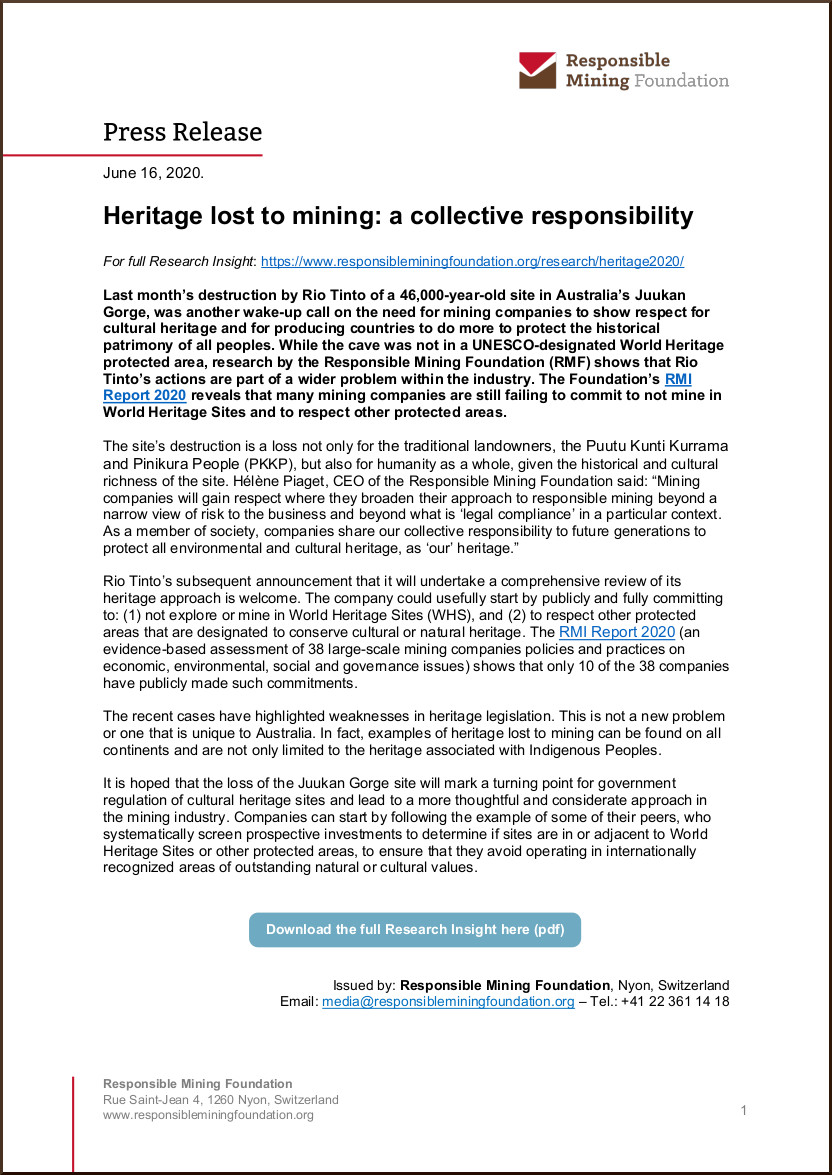Heritage lost to mining: a collective responsibility

|
Download the Press Release (pdf) ➥ English |
Last month’s destruction by Rio Tinto of a 46,000-year-old site in Australia’s Juukan Gorge, was another wake-up call on the need for mining companies to show respect for cultural heritage and for producing countries to do more to protect the historical patrimony of all peoples. While the cave was not in a UNESCO-designated World Heritage protected area, research by the Responsible Mining Foundation (RMF) shows that Rio Tinto’s actions are part of a wider problem within the industry. The Foundation’s RMI Report 2020 reveals that many mining companies are still not committing not to mine in World Heritage Sites and to respect other protected areas.
The site’s destruction is a loss not only for the traditional landowners, the Puutu Kunti Kurrama and Pinikura People (PKKP), but also for humanity as a whole, given the historical and cultural richness of the site. Hélène Piaget, CEO of the Responsible Mining Foundation said: “Mining companies will gain respect where they broaden their approach to responsible mining beyond a narrow view of risk to the business and beyond what is ‘legal compliance’ in a particular context. As a member of society, companies share our collective responsibility to future generations to protect all environmental and cultural heritage, as ‘our’ heritage.”
Rio Tinto’s subsequent announcement that it will undertake a comprehensive review of its heritage approach is welcome. The company could usefully start by publicly and fully committing to: 1. not explore or mine in World Heritage Sites (WHS), and 2. to respect other protected areas that are designated to conserve cultural or natural heritage. The RMI Report 2020 (an evidence-based assessment of 38 large-scale mining companies policies and practices on economic, environmental, social and governance issues) shows that only 10 of the 38 companies have publicly made such commitments.
The recent cases have highlighted weaknesses in heritage legislation. This is not a new problem or one that is unique to Australia. In fact, examples of heritage lost to mining can be found on all continents and are not only limited to the heritage associated with Indigenous Peoples.
It is hoped that the loss of the Juukan Gorge site will mark a turning point for government regulation of cultural heritage sites and lead to a more thoughtful and considerate approach in the mining industry. Companies can start by following the example of some of their peers, who systematically screen prospective investments to determine if sites are in or adjacent to World Heritage Sites or other protected areas, to ensure that they avoid operating in internationally recognized areas of outstanding natural or cultural values.
Or read the Research Insight online: www.responsibleminingfoundation.org/research/heritage2020
Responsible Mining Foundation
The Responsible Mining Foundation (RMF) is an independent research organisation that encourages continuous improvement in in responsible mining across the industry by developing tools and frameworks, sharing public-interest data and enabling informed and constructive engagement between mining companies and other stakeholders.
As an independent foundation, RMF does not accept funding or other contributions from the minerals and metals industry.